Internet Power, Volume 1: Flashback to the VHS-Era Web
Lately, I’ve started collecting old VHS tapes about the Internet from the early- to mid-1990s. While most of these are pretty corny — think Gabe and Max’s Internet Thing — they also inadvertently captured pieces of the web that don’t exist anywhere else. The Internet Archive’s earliest snapshots were in late 1996, so anything before that is extremely sparse. The videos, silly as they are, still represent valuable documentation of the early web.
I spent most of the day yesterday working on a workflow to digitize VHS tapes, settling on VCR to MiniDV camera my Macbook Pro with Firewire. These tapes are pretty worn, so the quality’s not great, but that almost adds to their charm.
Here’s the result: the first volume of a two-tape collection called “Internet Power!” from 1995. I’ve included some select quotes and screenshots below.
Internet Power – Discover the World of Online Entertainment (00:36)
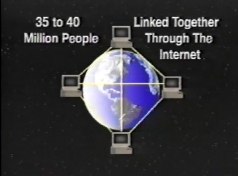
“The explosive growth in the number of people who have discovered the power of the Internet for learning, marketing and just plain having fun has been incredible. The Internet is changing the way we learn, work, and play forever. Today, some 35 to 40 million people from around the world are linked together through the Internet, the world’s largest computer network. Students of all ages are discovering the online power of the Internet as the ultimate tool for learning. Whether you’re in grade school or college or beyond, or you just want to be entertained and have a good time, the Internet has something for everyone.”
I love the Windows 3.1 references, and that they used 8-Ball Pool for Windows to demonstrate the power of the Internet.
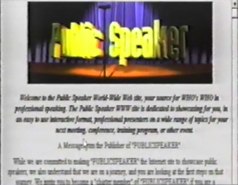 “But before we go too far, let’s take a moment and have a look at just what the Internet is and what it takes to start surfing through Cyberspace. You may already be a net surfer and you may want to skip this section, but if you’re just starting out, we suggest you spend a few minutes getting familiar with some of the most common Internet terms.”
“But before we go too far, let’s take a moment and have a look at just what the Internet is and what it takes to start surfing through Cyberspace. You may already be a net surfer and you may want to skip this section, but if you’re just starting out, we suggest you spend a few minutes getting familiar with some of the most common Internet terms.”
Dig that mid-1990s design aesthetic. Grey background, huge 3D rendered header graphic, Times New Roman italic, centered text… It’s 1995, all right.
“You’ll need a device to access the online world. That device is a Computer, with at least 386 power and 8 megabytes of RAM and has a modem installed that has 14.4 or greater speed or ‘baud rate.’ And of course, access to a phone line. If you have a slower modem, you will not be able to enjoy the growing multimedia aspects of the Internet, such as graphics, sound, and video.”
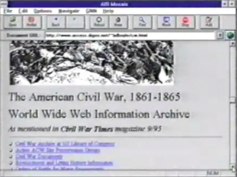 “You will also need a connection to the Internet that connects your computer to the millions of other computers that make up this Superhighway of Information.”
“You will also need a connection to the Internet that connects your computer to the millions of other computers that make up this Superhighway of Information.”
A number of vintage ISPs and screenshots are included, followed by an interview with a Microsoft tech named Bret Arsenault. Bret’s the only person interviewed in the video, as the resident expert.
“Any of the online services, such as America Online, will provide you with a connection to the Internet, along with a navigation tool called a Browser which enables you to move from location to location anywhere in the world.”
The browser pictured is AIR Mosaic, provided with Spry’s Internet in a Box.
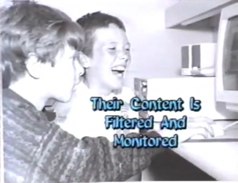 “Parents concerned about unwanted content may want to sign up with a major online service where you can be assured that their own content is filtered, and then have your child advise you when they’re going directly onto the World Wide Web and provide parental supervision as required. There are software packages in development that will assist parents in locking out unwanted Internet content in the future.”
“Parents concerned about unwanted content may want to sign up with a major online service where you can be assured that their own content is filtered, and then have your child advise you when they’re going directly onto the World Wide Web and provide parental supervision as required. There are software packages in development that will assist parents in locking out unwanted Internet content in the future.”
“The Internet has been around since the 1960s, but it was the development of the Mosaic browser in 1933 at the University of Illinois that made it possible to simply point and click your way to information that not only contained text, but also graphics. Now the average person can enjoy the full potential of the Internet, and especially, the fastest-growing part of the Internet called the World Wide Web.”
Yes, he said 1933. Apparently, the launch of Mosaic ushered in the Great Depression. Some nice shots of the original Smithsonian site, and a basic explanation of the Web by Arsenault and the narrator. How did you describe the Web in 1995?
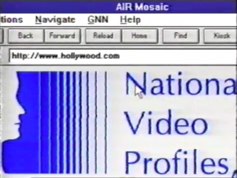 “A Web site is like a book that is divided into chapters. By clicking on the hypertext links, you choose which pages you want to view in the book. A Home Page is like the first page of the book, with a Table of Contents and general introduction into what is contained in the site.”
“A Web site is like a book that is divided into chapters. By clicking on the hypertext links, you choose which pages you want to view in the book. A Home Page is like the first page of the book, with a Table of Contents and general introduction into what is contained in the site.”
Next comes a brief introduction to domain names, FTP, Usenet, Gopher, and email, before launching into the next section: Search Engines.
“When it comes to fun and entertainment, the power of the Internet is unlimited!”
Search Engines (08:04)
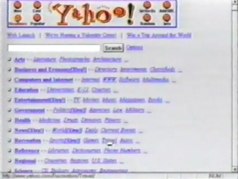 “To get started, we have to sift through the vast amounts of information on the Internet and find what we need. The best way to do this is by using one of the many Search Engines available. These sites gather the information that is out there and categorize it so we can narrow our search. One popular site to do this is called Yahoo!”
“To get started, we have to sift through the vast amounts of information on the Internet and find what we need. The best way to do this is by using one of the many Search Engines available. These sites gather the information that is out there and categorize it so we can narrow our search. One popular site to do this is called Yahoo!”
The list of search engines on the slide is a great flashback. “Web Crawler, Lycos, Einet, WWW Worm, Yahoo, Info Seek, Savvy Search… and More”
“Normally, these sites would take a few seconds to load to your computer, but in the interest of time, we’re cutting to them through editing for the purposes of this video.”
Later, they cover a long-lost site called “The Weatherman,” where you email your trip profile and a nice guy named George Gatto emails you a weather forecast by hand. I can’t imagine that’d scale very well.
Gopher (12:04)
“Gophers can be a one-stop source for finding information on the Internet. This particular site has many categories to choose from. Let’s keep our same subject, weather, to see how this differs from our Yahoo! search.”
Shopping (13:20)
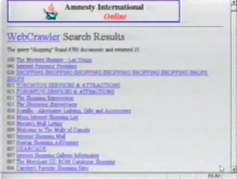 “The Internet has thousands of sites for shopping and many of them are grouped together in large Internet Malls… Let’s try a different search engine this time. We’ll use another popular one called Webcrawler.”
“The Internet has thousands of sites for shopping and many of them are grouped together in large Internet Malls… Let’s try a different search engine this time. We’ll use another popular one called Webcrawler.”
“Let’s choose one… The Mega Internet Shopping List sounds promising!”
I could go on all night. Later, they cover Online Games (16:36) and Online Entertainment (20:42), but the Online Magazines section (25:35) is my favorite, with screengrabs of Hotwired, Nintendo Power, and the craziest sitemap ever from a very early Time.com.
“You’ve got a lot of exploring to do, so surf wisely and have a great time!”
URL Addresses for Websites We Visited (27:35)
The Smithsonian, http://www.si.edu/
The Discovery Channel Online, http://www.discovery.com
The Weatherman, http://pixi.com/~gattoga/index.html
The Rock & Roll Hall of Fame Online, http://rockhall.com
Hollywood Online, http://www.hollywood.com
America Online, http://www.aol.com
Yahoo!, http://www.yahoo.com
The Internet Mall, http://www.mecklerweb.com:80/imall
The Toystore, http://www.toystore.com
Nintendo of America Online, http://www.nintendo.com
Happy Puppy Game Site, http://www.happypuppy.com
3D Riddler, http://cvs.anu.edu.au/andy/rid/riddle.html
CBS, http://www.cbs.com
NBC, http://www.nbc.com
PBS, http://www.pbs.com
ESPN, http://www.espnet.sportszone.com
Hotwired, http://www.hotwired.com
Time, http://www.timeinc.com
Price Costco Online, http://www.pricecostco.com
Credits (28:15)
Where are they now? Paul Barnett was Internet Power’s executive producer and it was produced, directed, and edited by Steve Ducharme — they later co-founded another company, the Internet broadcaster iShow. Bret Arsenault, originally an “Architectural Engineer, Internet Technology,” is now Microsoft’s Chief Security Advisor. (Here’s a recent webcast featuring Bret.)
Fun with VHS
Now that I’ve nailed the workflow, I’m going to be digitizing more of my collection. If you have any other classic Internet goodness locked up on VHS, get in touch. I’ll happily put it online for you.
Worst Website Ever, Redux
Yesterday’s Worst Website Ever session was standing-room only and judging from the response, it was a hit.
Once I can get a copy of the audio from the talk, I’ll upload a screencast of the entire session with the original slides. Until then, here are the descriptions of each pitch.
 Jeffery Bennett, Image Search for the Blind
Jeffery Bennett, Image Search for the Blind
Image search is fundamentally broken, only allowing sighted people to use it for entertainment and research. But what about those who can’t see? Jeffery shows how harnessing the collective vision of users can describe and annotate images for use by the blind.
Michael Buffington, Pressca.st
Bloggers have been used as a powerful promotional tool, but finding bloggers willing to sell themselves out for cash takes too long! Michael demonstrates a better way that combines the worst of Amazon’s Mechanical Turk and PayPerPost. Upload your press release, deposit funds with Paypal, and Turkers around the globe will instantly blog about your crappy product for pennies on the dollar. Evil!
Ben Brown & Katie Spence, Happy Net Box
Facebook broke new ground in allowing developers to create applications for their website, and the OpenSocial effort took it to the next level by allowing anyone to embed applications anywhere. Ben & Katie propose a groundbreaking new open platform: allowing developers to embed the entire Internet in your webpage with a single line of code. Don’t settle for a single application — embed the whole damn thing.
David Friedman, PeopleIPO
Take yourself public with an Individual Public Offering through PeopleIPO, allowing anyone to buy or sell shares in you! Watch as your personal life events affect your stock price, but be careful not to sell a majority stake in yourself — or you might become a slave to your shareholders.
Lia Bulaong, Sickr
The social network for contagious diseases, where online communities go viral. See who’s spread chlamydia, clap, or the common cold to their social network using a convenient Facebook badge, or just try to get to the top of the leaderboard with poor hygiene and/or risky sex. Fun for the whole family!
Merlin Mann, FlockdUp
FlockdUp.com is a best-of-breed hosted solution for networking Thought Leaders. Our Enterprise-class suite of tools empowers Topic Experts, Blog Consultants, Marketing Minds, and Social Mediapreneurs to tag, profile, remix, mash-up, *and* monetize every person that they know (or claim to know — we’re not here to judge). We understand that your career is hard to explain, and most people wouldn’t understand it anyway. That’s why FlockdUp does the heavy lifting with robust, integrated applications for connecting you directly to the thousands of enterprising mavericks whose email addresses you’ve collected. That’s right: Leading with Thoughts(tm). Sign-up today for very limited, private pre-Alpha at FlockdUp.com.
Lane Becker, MMOmmerce
The next generation of shopping, from the comfort of your very own fully immersive fantasy universe. Think Kozmo meets World of Warcraft: from clicks and mortar to clicks and Mordor, rampant consumerism becomes rampaging consumerism. All without leaving your desk!
The winner, as decided by guest VC/judge David Hornik, was Merlin Mann’s FlockdUp, followed closely by Jeffery Bennett’s Image Search for the Blind. Here’s a video of Merlin’s talk, courtesy of Roo Reynolds. Thank you so much to all the presenters and everybody who attended.
April 15: Jeffery Bennett’s footage from the audience is now available on Vimeo. I’m waiting for the official podcast audio from SXSW, and I’ll edit together a presentation with the original slides.
